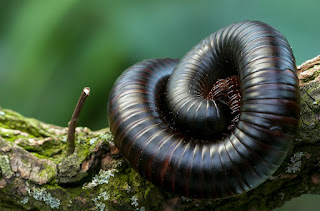Centipede images - Centipedes (from Latin prefix centi-, "hundred", and pes, pedis, "foot") are arthropods belonging to the class Chilopoda of the subphylum Myriapoda. They are elongated metameric creatures with one pair of legs per body segment. Centipedes are known to be highly venomous, and often inject paralyzing venom. Despite the name, centipedes can have a varying number of legs, ranging from 30 to 354. Centipedes always have an odd number of pairs of legs. Therefore, no centipede has exactly 100 legs. A key trait uniting this group is a pair of venom claws or forcipules formed from a modified first appendage. Centipedes are predominantly carnivorous.
Their size can range from a few millimetres in the smaller lithobiomorphs and geophilomorphs to about 30 cm (12 in) in the largest scolopendromorphs. Centipedes can be found in a wide variety of environments. They normally have a drab coloration combining shades of brown and red. Cavernicolous (cave-dwelling) and subterranean species may lack pigmentation, and many tropical scolopendromorphs have bright aposematic colours. (Wikipedia)
Their size can range from a few millimetres in the smaller lithobiomorphs and geophilomorphs to about 30 cm (12 in) in the largest scolopendromorphs. Centipedes can be found in a wide variety of environments. They normally have a drab coloration combining shades of brown and red. Cavernicolous (cave-dwelling) and subterranean species may lack pigmentation, and many tropical scolopendromorphs have bright aposematic colours. (Wikipedia)
Image Source:
pixabay.com
|
Centipede Images
Images of Centipede
Centipedes have a rounded or flattened head, bearing a pair of antennae at the forward margin. They have a pair of elongated mandibles, and two pairs of maxillae. The first pair of maxillae form the lower lip, and bear short palps. The first pair of limbs stretch forward from the body to cover the remainder of the mouth. These limbs, or maxillipeds, end in sharp claws and include venom glands that help the animal to kill or paralyze its prey.Many species of centipedes lack eyes, but some possess a variable number of ocelli, which are sometimes clustered together to form true compound eyes. However, these eyes are only capable of discerning light and dark, and have no true vision. In some species, the first pair of legs at the head end of the centipede acts as sense organs similar to antennae, but unlike the antennae of most other animals, theirs point backwards. Unusual sense organs found in some groups are the organs of Tömösváry. These are located at the base of the antennae, and consist of a disc-like structure with a central pore surrounded by sensory cells. They are probably used for sensing vibrations, and may even provide a sense of hearing.
See also: Cassowary Images
attention: all images contained on this "Centipede Images" page does not belong to this blog, the images used for information purposes only. If you are the owner of the image above and don't want the picture shown, please contact us and we'll remove it immediately. Thank you
|







No comments:
Post a Comment